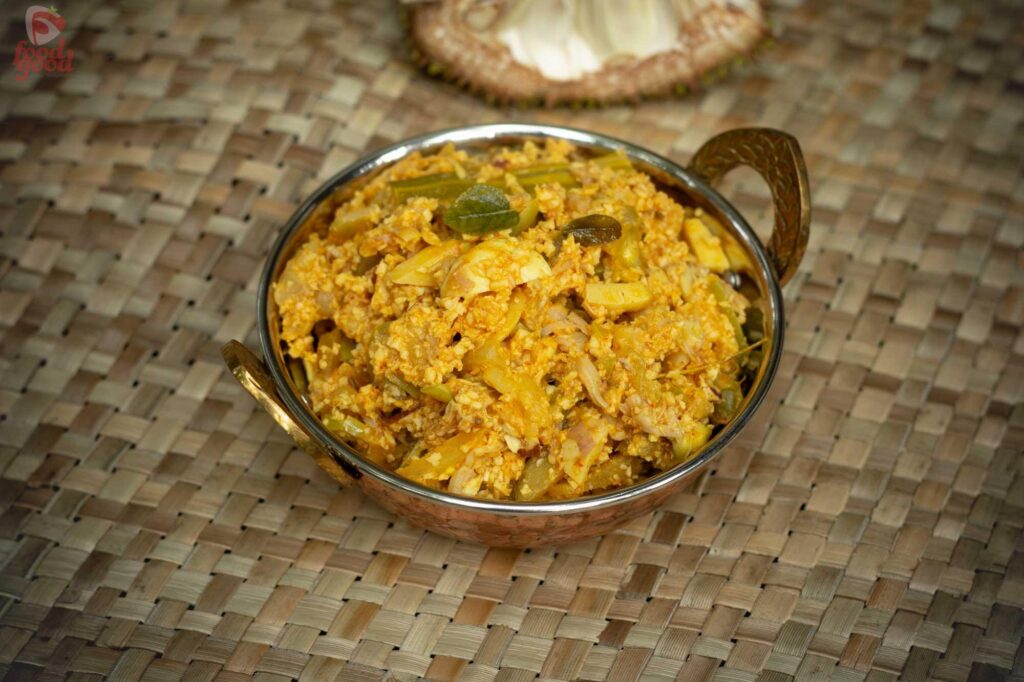In Kerala’s traditional kitchens, there’s a quiet pride in cooking without shortcuts – and Chakka Aviyal is one of those dishes that brings back the soul of old-style cooking. Made with raw jackfruit and crushed coconut, this curry isn’t just about taste – it’s about texture, tradition, and a story that runs deeper than the pot it’s cooked in.
As the name suggests, chakka (raw jackfruit) is the star here. It’s cooked with other simple ingredients, and for the essential sourness, raw mango is used – not tamarind, not curd. This brings a bright, natural tang that pairs perfectly with the mild sweetness and body of jackfruit.
But what makes this version of Chakka Aviyal truly special is the way the coconut is prepared – not in a mixie, not finely ground, but hand-crushed with a stone mortar and pestle. The result? A coarse, juicy, earthy coconut blend that soaks up spices and coats every piece of vegetable with a rustic charm you can’t get from a machine. Believe it or not, that rough texture and hand-pounded aroma make all the difference.
And then there’s aviyal itself – a dish with stories that span both mythology and royal kitchens.
One legend traces its origin to the Mahabharata, during the Pandavas’ exile. While living in disguise in King Virata’s palace, Bheema, the mighty warrior, took on the role of the royal cook. Faced with feeding a palace full of people and only leftover vegetables to work with, he chopped them all up, threw in some coconut, added a bit of sourness, and created what we now know as aviyal. What started as a dish of necessity became a feast of flavour.
A more grounded version comes from the time of the Travancore Kingdom, during the grand temple ritual of Murajapam at the Sree Padmanabhaswamy Temple. During this 56-day Vedic recitation, large-scale cooking was carried out to feed Brahmins and temple staff. It’s said that the chief cook once created a special curry using leftover vegetables, seasoned with coconut, turmeric, and raw mango – giving rise to what we now recognize as aviyal, adapted later in homes across the region.
Chakka Aviyal, then, is a beautiful branch of that old tree – carrying both the resourcefulness of the past and the richness of tradition. Served with rice, it’s filling, fibrous, slightly tangy, and deeply satisfying.
It reminds us that the best food isn’t always about rare ingredients or fancy equipment – sometimes, it’s about what’s left, how it’s treated, and the hands that make it.
Chakka Aviyal
Ingredients
Instructions
-
First of all, cut all the vegetables into long pieces (about 2½ inches in length).
-
Heat a traditional kalchatti (stone pot) or a clay pot. Add a teaspoon of coconut oil.
-
Add all the vegetables except jackfruit bulbs, green chillies, and mango pieces. Let them cook gently in their own moisture. Do not add water at this stage.
-
When the vegetables begin to soften, add turmeric powder, chilli powder, and green chillies. Stir gently and cook for a few more minutes.
-
Once the vegetables are almost cooked, add salt, jackfruit bulbs, and mango pieces. If needed, you may add a little water (traditionally, no water is added).
-
Now, using a mortar and pestle, crush grated coconut and cumin seeds into a coarse mixture.
-
Add this crushed coconut mix to the pot. Stir everything gently to combine the flavors.
-
Let it cook for a few more minutes until the raw smell disappears and the mixture comes together.
-
Finally, add fresh curry leaves and a spoon of coconut oil. Switch off the flame.
-
Your traditional Chakka Aviyal is now ready to be served.



Thanks for the recipe.
Welcome 🙏